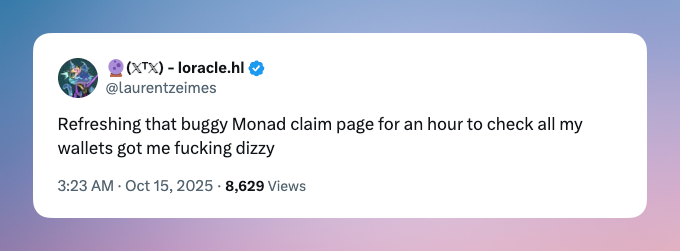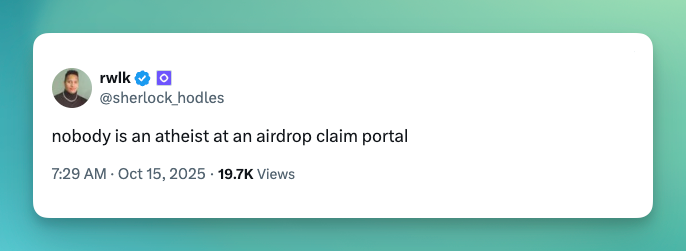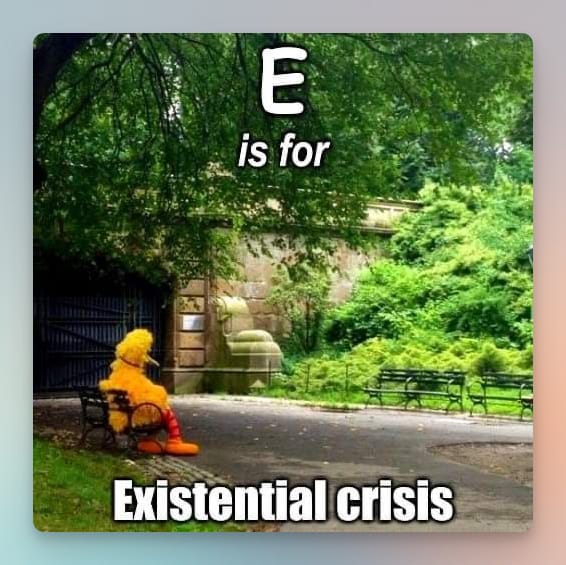Story One
Monad announces launch
Monad is another one of those alternative Layer-1s that fixes the flaws of Ethereum with its "most performant EVM-compatible" tech (their website, not my statement). They've been in testnet for what felt like an eternity in crypto terms (February this year), providing farmers ample time to spam Discord with gMonad.
Last week, the Monad team finally announced when they'd reward people's efforts, stating that their airdrop would be distributed to 5,500 core community members and 230,000 people in the larger crypto community. That said, the team had horrible timing, posting just after the guy in the White House wiped out $19 billion from the crypto market cap.
No wonder everyone rushed to check whether they were eligible for the MON token. The sudden spike in traffic overwhelmed Privy, the authentication provider, resulting in a partial outage.

On the bright side, the actual distribution won't start until much later, meaning if you think you should get some, you still have until November 3rd to claim.

Takeaway: Every time you think we're done with the Alt-EVM season, there's an airdrop to remind you that we aren't.
Story Two
Ethereum's existential crisis
As if it hadn't been hard enough to be a high-conviction ETH holder, as institutions pour in, Ethereum's issues seem to pivot from the price to the social layer. Some go so far as to call it Ethereum's existential crisis, realising that their favourite blockchain is at risk of corporate capture.

The moment that set fire to the corporate capture dialogue was Dankrad, a renowned Ethereum researcher joining Stripe's blockchain team. Bankless's obituary-esque further stoked the flames, and more builders spoke up about their experiences.

Among them Peter Szilagyi, former Go Ethereum Lead, who points out in an open letter that Ethereum failed him the second they dropped their values when money was on the table. In a similar vein, Polygon founder Sandeep shared his POV, highlighting the hypocrisy in how Polygon is treated and the lack of appreciation.
Latter points to a sentiment shared by grassroots organisers of ETH events: They find themselves in endless "let me introduce you to a person" loops rather than receiving concrete support.
Takeaway: The risk of corporate capture is real, the current Ethereum alignment purity tests a la Vitalik saying "if people ask for more money they are wrong here" won't fix it. I'm afraid that if they don't address their being-out-of-touch problem soon, we'll see more talent go the way of the money. In this economy, I can't even blame them.
Story Three
Opensea's fight for relevance
Remember Opensea? It was the go-to platform during the NFT pfp boom, back in the days when instead of Labubus, we'd be yolo-ing millions on ugly ape pictures. At least the latter aren't ending up in landfills.
As the forces of speculation took over, Opensea was vampire attacked by LooksRare, an NFT marketplace that didn't care about the art but only about the volumes. This sparked a race to the bottom on fees, eventually leading to breaking our promise to artists by making royalties optional.
Despite the decreased interest in NFTs, Opensea held on for dear life and still commands a significant market share for Ethereum NFTs. In an attempt to regain some mindshare, the team decided that it's time to give up on being exclusively focused on NFTs and brand itself as a "one-stop shop" for all one's crypto activity, instead, complete with trading, defi, etc.
Takeaway: Is it just me, or does everything eventually regress to trading? Zora did this. Now, Opensea. And the only somewhat notable crypto social app, Farcaster, too, is on track to turn into yet another trading app.
Fact of the week: On the theme of existential crisis, did you know that Kierkegaard, the first real existentialist, would have been a big proponent of anon accounts? Part of his publishing history involved using various pseudonyms to, at times, criticise his haters or engage in discussions with his other pseudonyms. Here is a list to highlight the extent of it.